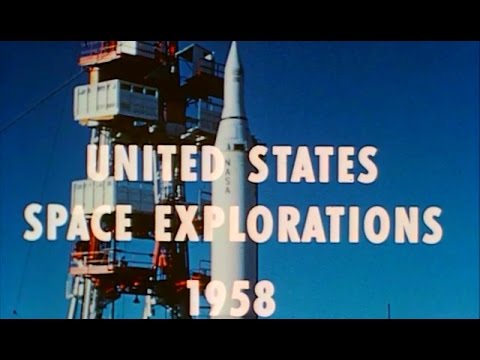video for embedding at
“The film describes preparation and launch of five satellites and two space probes during 1958.
On January 31, a Jupiter [Juno 1] vehicle launched Explorer I into space. Data from this satellite was used to identify the van Allen radiation belts.
On March 17, a Vanguard I rocket launched an Earth satellite with solar batteries. Data from the mission was used to determine that the Earth is slightly pear-shaped.
On March 26, Explorer III was launched to further study the van Allen belts, micrometeoroid impacts, and internal and external temperatures.
Explorer IV, launched on July 26, was intended to study radiation and temperature data.
A lunar probe, ABLE I, was intended to measure radiation, magnetic fields of Earth and the Moon, density of micrometeoric matter, and internal temperatures. A four-stage rocket was used in the launch. However, a turbo-pump failed and the liquid oxygen pump stopped, resulting in a failed mission.
On October 10, Pioneer I was launched by an ABLE vehicle. First and second stage velocity was less than desired and the probe did not leave Earth orbit. Attempts to attain escape velocity were unsuccessful.
On December, a Jupiter boost vehicle was used to launch Juno II, with Pioneer III as the payload. Escape velocity was reached and Pioneer III left Earth’s atmosphere.
Failed launches, such as those of Vanguard boost vehicles and several Explorer satellites, also added to scientific knowledge.”
Public domain film from NASA, slightly cropped to remove uneven edges, with the aspect ratio corrected, and mild video noise reduction applied.
see also: Explorer 1: “The Big Picture: Army Satellites” 1958 US Army
841 page .pdf: From PEENEMUNDE to OUTER SPACE
Commemorating the Fiftieth Birthday of Wernher von Braun March 23, 1962
“The Juno 1 and Juno 2 vehicles, both four-stage rocket systems, were conceived as fast and thrifty solutions for launching satellites and space probes. Both were developed by the former Development Operations Division of the Army Ballistic Missile Agency (contributing the first stages, guidance and control systems, and the launching) and by the Jet Propulsion Laboratory (contributing the high-speed upper stage assembly).
The composition of these multistage carrier vehicles was characterized by the choice of thoroughly proven components. It was intended that required modifications of existing hardware would not impair the reliability of the vehicles. Thus it became possible to provide, with existing means, a workable rocket system carrying payloads ranging from a maximum of 25 lb for Juno 1 to a maximum of 92 lb for Juno 2 (Table 9.1). Both vehicles evolved from the Jupiter C, a composite reentry test vehicle developed by the Army for investigating the aerodynamic heating of missile nose cones when diving into the Earth’s atmosphere. The main difference between Juno 1 and Juno 2 was in the first stage (Figs. 9.1 and 9.2). Juno 1’s main stage was a modified Redstone ballistic missile while a modified version of the more powerful Jupiter ICBM was Juno 2’s main
stage.
Both vehicles had the same arrangement of high-speed solid propellant stages. Their second stages were powered by 11 solid propellant motors, and the third stages consisted of three such motors; a single motor was used on their fourth stages. The payload was attached directly `to the top of the fourth stage. The high-speed stage motors were clustered symmetrically about the longitudinal vehicle axis and housed in a cylindrical launcher. With a concentrically arranged shaft, this launcher could rotate in ball bearings, supported by the forward end of the first stage instrument compartment. Spinning of the high-speed stages was mandatory to minimize slight thrust differences between the motors. A shroud was introduced for the Juno 2 vehicle for protection from greater aerodynamic heating during the ascending part of the trajectory and for support of an angle-of-attack meter located in front…
The Juno l program began with the launching of Explorer 1 on January 31, 1958, and ended on October 22, 1958 with an attempt to launch Beacon 1. Pioneer 1, a space probe, launched on December 6, 1958, was the first flight of the Juno 2 series. The launching of payload AM-19G on May 24, 1961 completed this series.”
NASA, Explorer, Explorer I, Juno, Jupiter-C, Juno I, Pioneer, Able, space, satellite, first US satellite, space exploration, Vanguard, rocket, rocket launches, launch vehicles

